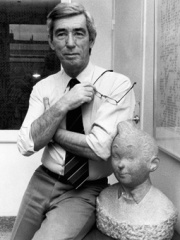
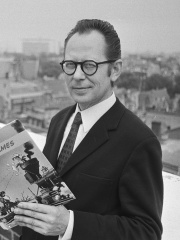
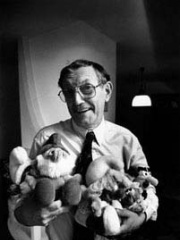
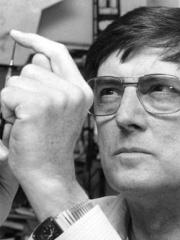
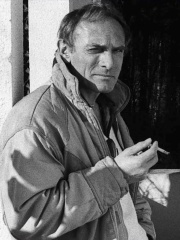
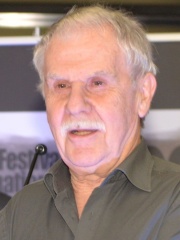
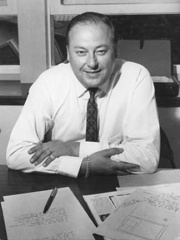
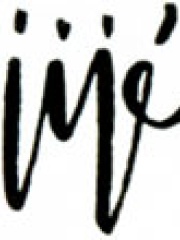
The Most Famous
COMIC ARTISTS from Belgium
This page contains a list of the greatest Belgian Comic Artists. The pantheon dataset contains 226 Comic Artists, 11 of which were born in Belgium. This makes Belgium the birth place of the 5th most number of Comic Artists behind France, and United Kingdom.
Top 10
The following people are considered by Pantheon to be the top 10 most legendary Belgian Comic Artists of all time. This list of famous Belgian Comic Artists is sorted by HPI (Historical Popularity Index), a metric that aggregates information on a biography's online popularity. Visit the rankings page to view the entire list of Belgian Comic Artists.

1. Hergé (1907 - 1983)
With an HPI of 75.44, Hergé is the most famous Belgian Comic Artist. His biography has been translated into 63 different languages on wikipedia.
Georges Prosper Remi (French: [ʒɔʁʒ pʁɔspɛʁ ʁəmi]; 22 May 1907 – 3 March 1983), known by the pen name Hergé ( air-ZHAY; French: [ɛʁʒe] ), from the French pronunciation of his reversed initials RG, was a Belgian comic strip artist. He is best known for creating The Adventures of Tintin, the series of comic albums that are considered one of the most popular European comics of the 20th century. He was also responsible for two other well-known series, Quick & Flupke (1930–1940) and The Adventures of Jo, Zette and Jocko (1936–1957). His works were executed in his distinctive ligne claire drawing style. Born to a lower-middle-class family in Etterbeek, Brussels, Hergé began his career by contributing illustrations to Scouting magazines, developing his first comic series, The Adventures of Totor, for Le Boy-Scout Belge in 1926. Working for the conservative Catholic newspaper Le Vingtième Siècle, he created The Adventures of Tintin in 1929 on the advice of its editor Norbert Wallez. Revolving around the actions of boy reporter Tintin and his dog Snowy, the series' early instalments – Tintin in the Land of the Soviets, Tintin in the Congo, and Tintin in America – were designed as conservative propaganda for children. Domestically successful, after serialisation the stories were published in book form, with Hergé continuing the series and also developing both the Quick & Flupke and Jo, Zette and Jocko series for Le Vingtième Siècle. Influenced by his friend Zhang Chongren, from 1934 Hergé placed far greater emphasis on conducting background research for his stories, resulting in increased realism from The Blue Lotus onward. Following the German occupation of Belgium in 1940, Le Vingtième Siècle was closed, but Hergé continued his series in Le Soir, a popular newspaper controlled by the Nazi administration. After the Allied liberation of Belgium in 1944, Le Soir was shut down and its staff – including Hergé – accused of having been collaborators. An official investigation was launched, and although no charges were brought against Hergé, in subsequent years he repeatedly faced accusations of having been a traitor and collaborator. With Raymond Leblanc he established Tintin magazine in 1946, through which he serialised new Adventures of Tintin stories. As the magazine's artistic director, he also oversaw the publication of other successful comics series, such as Edgar P. Jacobs' Blake and Mortimer. In 1950 he established Studios Hergé as a team to aid him in his ongoing projects; prominent staff members Jacques Martin and Bob de Moor greatly contributed to subsequent volumes of The Adventures of Tintin. Amid personal turmoil following the collapse of his first marriage, he produced Tintin in Tibet, his personal favourite of his works. In later years he became less prolific, and unsuccessfully attempted to establish himself as an abstract artist. Hergé's works have been widely acclaimed for their clarity of draughtsmanship and meticulous, well-researched plots. They have been the source of a wide range of adaptations, in theatre, radio, television, cinema, and computer gaming. He remains a strong influence on the comic book medium, particularly in Europe. He is widely celebrated in Belgium: a Hergé Museum was established in Louvain-la-Neuve in 2009.

2. Morris (1923 - 2001)
With an HPI of 70.35, Morris is the 2nd most famous Belgian Comic Artist. His biography has been translated into 39 different languages.
Maurice De Bevere (Dutch: [moːˈriz də ˈbeːvərə]; French: [mɔʁis də bəvɛʁ, moʁ-]; 1 December 1923 – 16 July 2001), better known as Morris, was a Belgian comics artist, illustrator and the creator of Lucky Luke, a bestselling comic series about a gunslinger in the American Wild West. He was inspired by the adventures of the historic Dalton Gang and other outlaws. It was a bestselling series for more than 50 years that was translated into 23 languages and published internationally. He collaborated for two decades with French writer René Goscinny on the series. Morris's pen name is an Anglicized version of his first name.

3. Peyo (1928 - 1992)
With an HPI of 69.33, Peyo is the 3rd most famous Belgian Comic Artist. His biography has been translated into 35 different languages.
Pierre Culliford (French: [kylifɔʁd]; 25 June 1928 – 24 December 1992) was a Belgian comics writer and artist who worked under the pseudonym Peyo ([pejo]). His best-known works are the comic book series The Smurfs and Johan and Peewit, in the latter of which the Smurfs made their first appearance.

4. André Franquin (1924 - 1997)
With an HPI of 66.94, André Franquin is the 4th most famous Belgian Comic Artist. His biography has been translated into 36 different languages.
André Franquin (French: [fʁɑ̃kɛ̃]; 3 January 1924 – 5 January 1997) was an influential Belgian comics artist, whose best-known creations are Gaston and Marsupilami. He also produced the Spirou et Fantasio comic strip from 1946 to 1968, a period seen by many as the series' golden age.
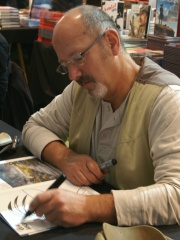
5. Benoît Sokal (1954 - 2021)
With an HPI of 60.23, Benoît Sokal is the 5th most famous Belgian Comic Artist. His biography has been translated into 20 different languages.
Benoît Sokal (28 June 1954 – 28 May 2021) was a Belgian comic artist and video game developer, best known for his comics series Inspector Canardo, and the Syberia adventure game franchise.

6. Jean Van Hamme (b. 1939)
With an HPI of 58.67, Jean Van Hamme is the 6th most famous Belgian Comic Artist. His biography has been translated into 16 different languages.
Jean Van Hamme (born 16 January 1939) is a Belgian novelist and comic book writer. He has written scripts for a number of Belgian/French comic series, including Histoire sans héros, Thorgal, XIII and Largo Winch.

7. Hermann Huppen (b. 1938)
With an HPI of 58.06, Hermann Huppen is the 7th most famous Belgian Comic Artist. His biography has been translated into 15 different languages.
Hermann Huppen (born 17 July 1938) is a Belgian comic book creator. He is better known under his pen-name Hermann. He is most famous for his post-apocalyptic comic Jeremiah which was made into a television series.

8. Jean-Michel Charlier (1924 - 1989)
With an HPI of 57.41, Jean-Michel Charlier is the 8th most famous Belgian Comic Artist. His biography has been translated into 17 different languages.
Jean-Michel Charlier (French: [ʒɑ̃ miʃɛl ʃaʁlije]; 30 October 1924 – 10 July 1989) was a Belgian comics writer. He was a co-founder of the famed Franco-Belgian comics magazine Pilote.

9. Jijé (1914 - 1980)
With an HPI of 57.29, Jijé is the 9th most famous Belgian Comic Artist. His biography has been translated into 16 different languages.
Joseph Gillain (French: [ʒilɛ̃]), better known by his pen name Jijé ([ʒiʒe]; 13 January 1914 – 19 June 1980), was a Belgian comics artist, best known for being a seminal artist on the Spirou et Fantasio strip (and for having introduced the Fantasio character) and the creator of one of the first major European western strips, Jerry Spring.
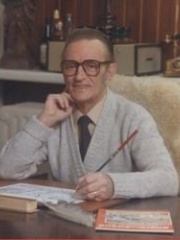
10. Willy Vandersteen (1913 - 1990)
With an HPI of 56.68, Willy Vandersteen is the 10th most famous Belgian Comic Artist. His biography has been translated into 16 different languages.
Willebrord Jan Frans Maria "Willy" Vandersteen (15 February 1913 – 28 August 1990) was a Belgian creator of comic books. In a career spanning 50 years, he created a large studio and published more than 1,000 comic albums in over 25 series, selling more than 200 million copies worldwide. Considered together with Marc Sleen the founding father of Flemish comics, he is mainly popular in Belgium, the Netherlands and Germany. Hergé called him "The Brueghel of the comic strip", while the creation of his own studio and the mass production and commercialization of his work turned him into "the Walt Disney of the Low Countries". Vandersteen is best known for Suske en Wiske (published in English as Spike and Suzy, Luke and Lucy, Willy and Wanda or Bob and Bobette), which in 2008 sold 3.5 million books. His other major series are De Rode Ridder with over 200 albums and Bessy with almost 1,000 albums published in Germany.
People
Pantheon has 11 people classified as Belgian comic artists born between 1907 and 1954. Of these 11, 2 (18.18%) of them are still alive today. The most famous living Belgian comic artists include Jean Van Hamme, and Hermann Huppen. The most famous deceased Belgian comic artists include Hergé, Morris, and Peyo.
Living Belgian Comic Artists
Go to all RankingsDeceased Belgian Comic Artists
Go to all RankingsHergé
1907 - 1983
HPI: 75.44
Morris
1923 - 2001
HPI: 70.35
Peyo
1928 - 1992
HPI: 69.33
André Franquin
1924 - 1997
HPI: 66.94
Benoît Sokal
1954 - 2021
HPI: 60.23
Jean-Michel Charlier
1924 - 1989
HPI: 57.41
Jijé
1914 - 1980
HPI: 57.29
Willy Vandersteen
1913 - 1990
HPI: 56.68
Greg
1931 - 1999
HPI: 53.85
Overlapping Lives
Which Comic Artists were alive at the same time? This visualization shows the lifespans of the 9 most globally memorable Comic Artists since 1700.


